Many lilies feature large, eye-catching blooms. While white is often thought of as the traditional color of lilies, the color palette for these flowers is much broader than that. Along with white, lilies come in lovely shades of red, pink, orange, purple, and yellow.
Yellow lilies bring a bright, sunny vibe to your garden, flowerbed, or home. Unfortunately, there aren’t quite as many yellow options as you will find with other lily colors, but there are still several to choose from. Here are five of our favorites. Some of them might become your favorites, too.
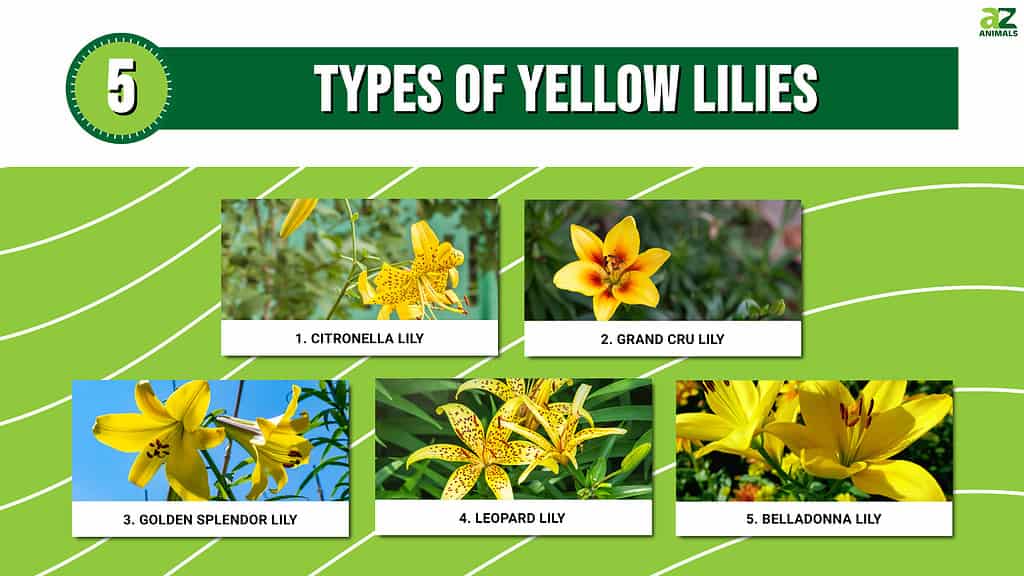
1. Citronella Lily (Lilium ‘Citronella’)
- USDA Hardiness Zones: 4-8
- Height: 3-5 feet
- Sun Exposure: Full, partial
This Asiatic lily grows to five feet tall. The plant features showy golden amber to lemon yellow blooms with brown or black speckles. The pendant flowers with reflexed petals bloom in early-mid summer. When you add these extra showy blooms to a five-foot plant, that is going to be one eye-catching lily!
While the Citronella lily won’t ward off mosquitoes as its name suggests, there is evidence that it is resistant to the lily beetle. That is music to the ears of any lily grower who has seen plants damaged or destroyed by this pest. The plant will also attract pollinators such as bees.
The Citronella lily produces more flowers as it becomes established. After a few growing seasons, each stem can produce upwards of 20 blossoms.
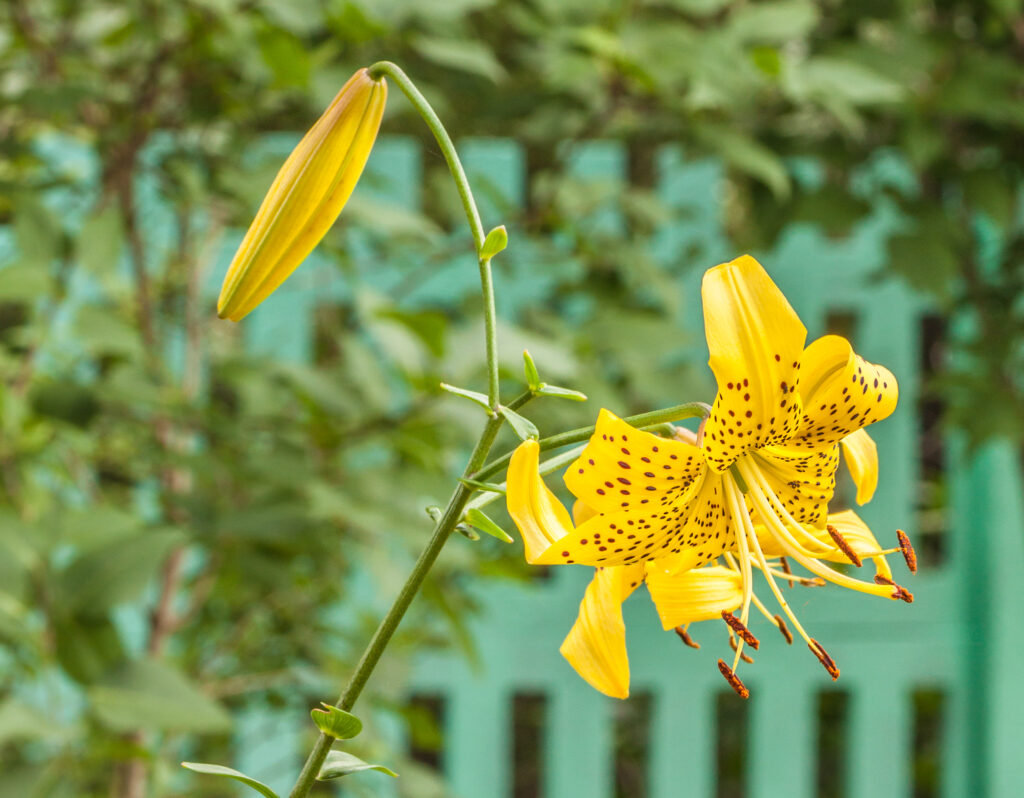
The Citronella lily features cheery yellow pendant blooms with black or brown speckles.
©Sarycheva Olesia/Shutterstock.com
2. Grand Cru Lily (Lilium ‘Grand Cru’)
- USDA Hardiness Zones: 4-8
- Height: 3-4 feet
- Sun Exposure: Full, partial
There is nothing subtle about the Grand Cru lily. It really is grand in every way. The large blooms on this four-foot plant are bright yellow with a brush of maroon/burgundy in the center. It’s like growing sunshine in your garden!
Unlike the pendant blooms of the Citronella lily, the Grand Cru lily’s open six-petaled blooms face upward. This Asiatic lily is a favorite of bees and butterflies.
Along with outdoor gardens, the Grand Cru lily is also well-suited for containers and makes a stunning addition to cut flower arrangements.

The blooms of the Grand Cru feature six petals of bright yellow brilliance!
©itasun/Shutterstock.com
3. Golden Splendor Lily (Lilium ‘Golden Splendor’)
- USDA Hardiness Zones: 4-8
- Height: 3-4 feet
- Sun Exposure: Full, partial
The Golden Splendor lily could not be more aptly named. Its large golden blooms add splendor and beauty to any growing environment. It’s also quite easy to grow, as well. It will grow in various soils as long as there is adequate drainage. This plant is also more drought-tolerant than many other lilies.
The Golden Splendor lily grows up to four feet tall and blooms in mid-late summer. Most Asiatic are unscented, but trumpet lilies, such as the Golden Splendor, feature a delightful fragrance.
The trumpet flowers of this lily face outward and feature golden yellow on the inside and burgundy or violet on the outside. You are not the only one that will love these blooms, though. The Golden Splendor lily is a pollinator favorite, attracting butterflies, bees, and hummingbirds.
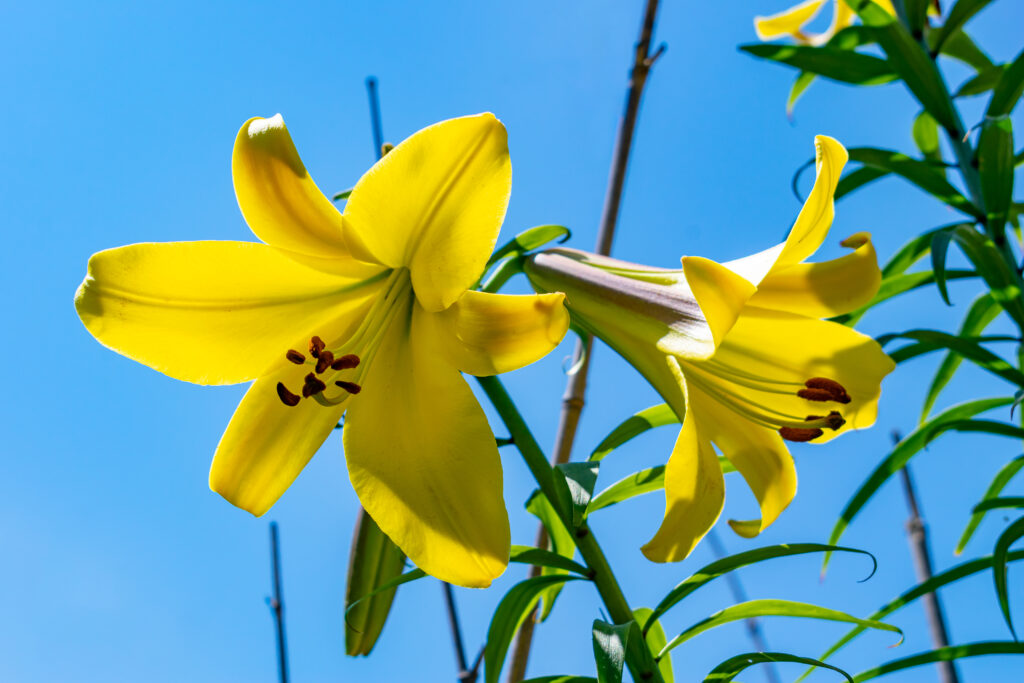
The outward-facing trumpet blooms of the Golden Splendor lily are eye-catchers!
©CoinUp/Shutterstock.com
4. Leopard Lily (Lilium pardalinum)
- USDA Hardiness Zones: 5-8
- Height: 6-8 feet
- Sun Exposure: Partial
This lily is known by several big cat names, such as the “Leopard lily,” “Panther lily,” and “California Tiger lily.” Whichever cat name you prefer, this lily is a stunner with its spotted nodding blooms. The spots resemble those of a leopard, hence its common feline name.
The blooms are often orange-red with a transition to yellow near the center, but some also feature completely yellow blooms with the flower’s trademark leopard spots.
This lily is a wildflower native to California and southern Oregon. It can be found near stream banks, bogs, and woodlands up to 6,000 feet along the Sierra Nevada and the California coastal range. Hummingbirds, bees, and butterflies pollinate this plant in its native habitat and will do the same when it is planted in your garden. The plant grows to heights of up to eight feet and blooms in early-mid summer. It can handle more shade than many lilies, which opens up more options for potential planting sites.
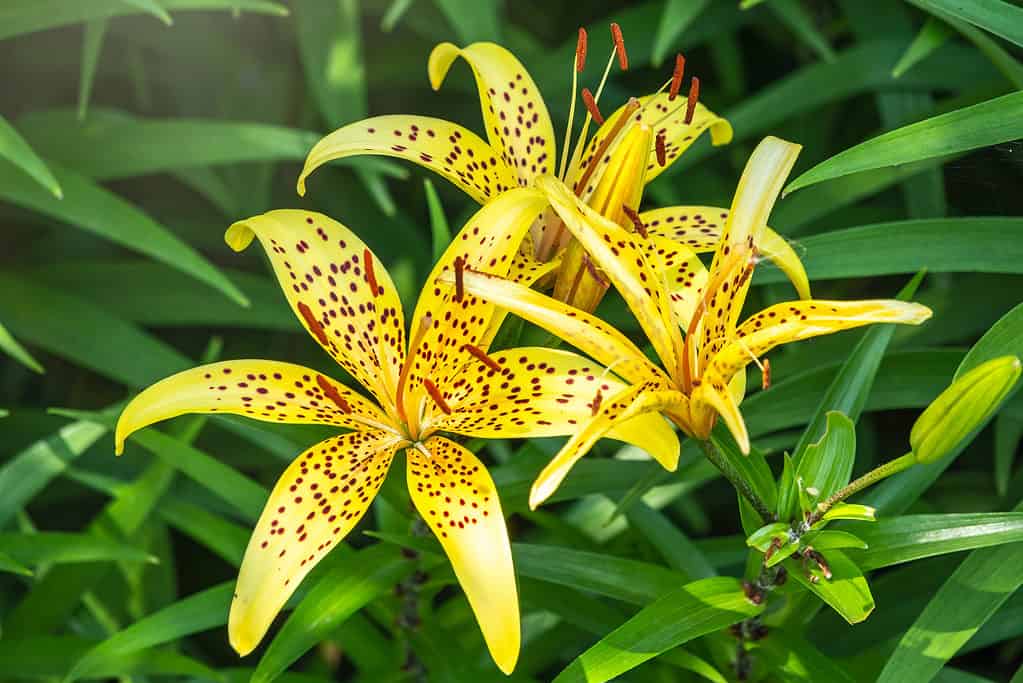
The Leopard lily features beautiful leopard-like spots.
©iStock.com/Dmitry Potashkin
5. Belladonna Lily (Lilium ‘Belladonna’)
- USDA Hardiness Zones: 5-9
- Height: 4 feet
- Sun Exposure: Full, partial
The Belladonna is an Orienpet lily, meaning it is a hybrid of Oriental and Trumpet lilies. This plant is a triumph of hybridization, as Orientpet lilies retain the best qualities of both parent plants. Orienpet lilies are disease resistant. They are also more drought-tolerant than the parent plants. Orienpet lilies are also more cold and heat tolerant than many other lilies. These hybrids are among the easiest-to-grow lilies on the market today.
The Belladonna lily is a mid-late summer bloomer and is a magnet for bees and butterflies. The golden blooms can measure up to seven inches and feature a light, pleasant fragrance.

The Belladonna lily features large golden-yellow blooms with a light fragrance.
©JOACHIM CH/Shutterstock.com
Tips for Growing Lilies
Planting and Watering
Most lilies can thrive in partial to full sun. An ideal planting site would receive six hours of daily sunlight.
Lily bulbs are best planted in the spring or fall. Dig a six-inch hole and add some bone meal to give the plant a slow release of nutrients. When planting multiple lilies, separate the holes by about three times the width of the bulb. Water the bulb deeply after planting.
Lilies don’t like to be waterlogged, but they do require consistent moisture. Plan to water your lilies often through the entire growing season.
Also, most lilies benefit from deadheading during the growing season. Removing the spent blooms allows the plant to focus all its energy and nutrients on the healthy blooms.
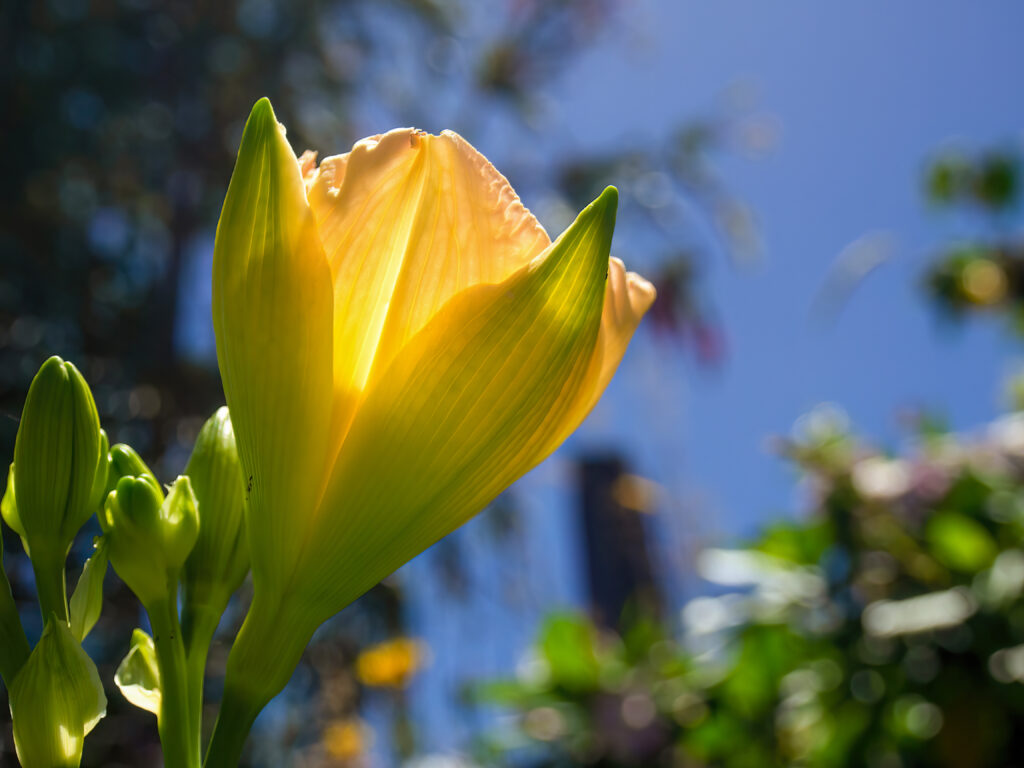
Most lilies need plenty of sunlight each day.
©iStock.com/Mauricio Acosta
Common Lily Pests
One of the few drawbacks to lilies is their vulnerability to pests. Aphids love lilies, as do lily beetles, slugs, lily thrips, and lily weevils. These pests can damage or even destroy a lily plant with amazing speed.
Organic options such as diluted neem oil can be effective at removing some of these pests, but time is not on your side when facing an infestation. These pests can make quick work of destroying a lily plant. If organic solutions aren’t doing the job and you want to save your lilies, a synthetic pesticide may be your only option. Carefully follow all the label instructions to apply it safely. Organic pesticides are better for the environment and safer for the gardener, so chemicals should always be used sparingly and as a last resort.
Gray mold (Botrytis blight) is also a common problem for lilies. This disease is often fatal for the plant. Fungicide treatments can be applied to prevent the disease, but there is no cure once it is present on a lily.
Common animals such as rabbits and deer are known to munch on lilies, though they don’t often completely destroy the plants. You can try a commercial repellent if these animals are common in your area.

The leaves of this lily have been damaged by rabbits.
©Mark R Coons/Shutterstock.com
Toxicity
It is very important to note that most lilies, including the ones listed above, are highly toxic to cats, even to the point of being lethal.
The most common issue for cats caused by lilies is Acute Kidney Injury (AKI). Some lilies are so toxic to cats that the pollen alone can cause AKI. Symptoms of AKI include anorexia and vomiting.
Most lilies are perfectly safe for dogs. It is still a good idea to keep your pup away, though, just to be on the safe side.
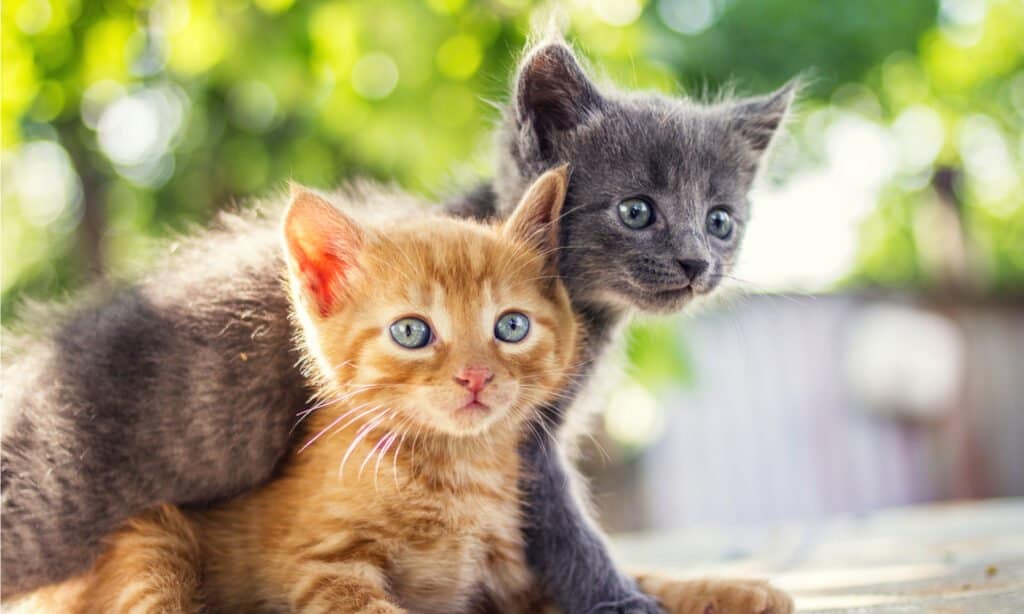
Keep your kitties healthy by keeping them away from lilies!
©CebotariN/Shutterstock.com
Summary of 5 Types of Yellow Lilies
| # | Yellow Lily | Sun Exposure |
|---|---|---|
| 1 | Citronella Lily | Full to partial |
| 2 | Grand Cru Lily | Full to partial |
| 3 | Golden Splendor Lily | Full to partial |
| 4 | Leopard Lily | Partial |
| 5 | Belladonna Lily | Full to partial |
The photo featured at the top of this post is © iStock.com/itasun
Thank you for reading! Have some feedback for us? Contact the AZ Animals editorial team.






